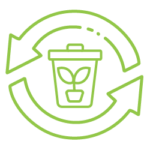There is a myriad of health problems for people and wildlife linked to plastic. From birds mistaking plastic for food to hungry sea turtles thinking plastic bags are jellyfish.
This issue just does not affect marine and wildlife. According to The Center for Biological Diversity, the average human consumes the equivalent of a credit card of plastic every week. Microplastics are believed to be consumed by humans through food and the air.
The United States generates more plastic trash than any other nation according to National Geographic. The two leaders in single-use plastics are the U.S companies Exxon Mobil, and Dow. The single-use plastic industry is projected to grow by 30% over the next five years.
It can be overwhelming to try and comprehend the effect single-use plastics have on our
environment. The average person may be surprised to learn how little plastic actually makes it to the recycling process. Of the seven billion tons of plastic waste, only 10% has been recycled.
There are some steps people can take to help reduce the plastic waste problem. One solution is to carry a reusable grocery bag. Another step is to stop using plastic straws. When dining out, bring your own take-out containers. It is up to the individual to make the right choices in preserving a healthy environment for us and the rest of the world.

How Did We Get Here?
Ironically, plastic was invented in the late 1800s to protect nature. The high demand for ivory, tortoiseshell, and horn could be curbed with this new, manufactured alternative. Newer, cheaper, and more sophisticated plastics increased through the 1930s.
In the 1940s, World War II increased the use of plastics enormously. Helmets, parachutes, rain gear, and even plane parts were being pumped out in record amounts. After the war, U.S. plastic production turned to consumer goods. More and more products, such as glass, fabrics, and wood, were replaced with this “wonder material”. The 20th century truly became a century of plastics, making many goods accessible to everyone. By the 1960’s it became clear that we were creating a huge environmental problem.
Here in the early 20th century, the problem is clearly critical. Plastic, especially single-use plastic items, such as plastic bottles, straws, and shopping bags is an ever-increasing threat to life on our planet. Many birds, sea turtles, and other creatures mistake plastic items, such as bags, for food.
We humans are affected too: the average human consumes the equivalent of a credit card of plastic every week, in the form of microplastics in our food and the air.
Who Is Responsible?
More than 55% of the world’s single-use plastics are created by twenty international companies most of whom are petrochemical companies. The two leaders in single-use plastics are both U.S.-based companies: Exxon Mobil, and Dow. ExxonMobil alone contributes 5.9 million metric tons each year to global plastic waste!
There is no end in sight as demand continues to grow. While fingers point back and forth all around the globe, the U.S. is considered to be the highest per-capita user of disposable plastics, followed closely by our friends in the UK.
The U.S.A. Can Do Better!
Unfortunately, we the people of the United States generate more plastic trash per capita than any other nation. Although we represent only 4% of the global population we generate roughly 17% of all plastic waste.
But We Recycle, Right?
Yes. We have made gains in recycling. But the average person may be surprised to learn that only 10% of our plastic waste makes it through the recycling process.
Is There Anything I Can Do?
YES! While it can be overwhelming to consider the scope of the problem we CAN make a difference. Here are THIRTEEN THINGS you can do!
Remember: Think globally: act locally! Here’s how:
- We’re Better Together. Get Involved!
Join the community, state, national, and even global organizations that are working to solve the problems. HHGTF is your local green community. Join us!
Charity Navigator lists the best environmental groups across all categories. Use this link to explore their highly-rated environmental non-profits across many categories. - Stay informed.
While it can be difficult to hear and see the problems, it is important to understand the true situation. Opt for more scientific and research-based information when possible. - Reduce. Reuse. Recycle.
People often forget that the first line of defense is to REDUCE the use of waste, including single-use plastics. Here are some simple ways: - Choose reusable grocery bags AND produce bags.
You can re-use the ones from the store, or invest in some top notch bags on Amazon or other sources. - Just say NO to plastic straws.
Perhaps even urge the restaurant to resume using paper straws! - Bring your own “take-home” containers
When dining out, bring your own containers for left-overs. Glass or stainless steel are best to avoid plastic contamination from warm foods. - Use a refillable water bottle.
There are many commercial bottles available. But you can innovate! Empty spaghetti sauce jars are great, free, lidded bottles! - Use refillable bottles for basic necessities.
Some local grocers (Heinens, Whole Foods) offer refills on bulk olive oil, beer growlers, shampoos, and other basic necessities. Check for details at each establishment. - Visit the “deli-counter”.
You can request that they wrap your cheeses, meats, and fish in butcher paper without plastic, rather than purchase pre-packaged goods. - Disposable paper products.
For times when you must use disposable products, choose renewable sourced materials if possible. Cups, plates, table covers, toilet paper, paper towels and even diapers can be made from recycled paper, bamboo, or even hemp! Unbleached options are best! You can purchase most locally, or find a wide variety of options on Amazon!
Or skip the disposable and opt for washable glass, fabric, or stainless steel products. - Sandwich Bag Alternatives.
Remember waxed paper? It still works! A “modern” option is beeswax wraps. Not only are they reusable and sustainable, but they don’t leach harmful chemicals into your food! (That’s another big story!) - Look for Non-Plastic Packaging
Many companies are beginning to offer alternative packaging! Boxed soups, frozen veggies, and even laundry sheets can now be purchased in cardboard boxes! Look for Cardboard and Paper Packaging. - Reuse what you already have.
Plastic is everywhere! Reuse or find new uses for plastics you already have.
We really do “vote with our dollars”. By purchasing products that don’t use more sustainable materials we send a strong signal to companies; they will continue to move in that direction.
Plastic will be with us for a long time…and it CAN be useful for many things such as medical and safety products! It is the casual and one-time convenience usage that we should strive to eliminate.
We are all in this together. Let’s work together AND as individuals to steer our earth-ship in a healthier and safer direction.
Information for this article was gathered from these sources:
- National Geographic: “U.S. Plastic Pollution”
https://www.nationalgeographic.com/environment/article/us-plastic-pollution - NRDC: “Single-Use Plastics”
https://www.nrdc.org/stories/single-use-plastics-101 - CNBC: “Just 20 companies are responsible…”
https://www.cnbc.com/2021/05/18/20-companies-responsible-for-55percent-of-single-use-plastic-waste-study.html - The Center for Biodiversity:
https://www.biologicaldiversity.org/about/ - Minderoo: Revealed: “Business and Banks Behind Global Plastic Waste Crisis”
https://www.minderoo.org/plastic-waste-makers-index/news/revealed-businesses-and-banks-behind-global-plastic-waste-crisis/ - Plaine Products: “The History of Plastic”
https://www.plaineproducts.com/why-we-need-to-understand-the-history-of-plastic-before-we-can-tackle-the-problem/ - World Wide Fund For Nature (formerly World Wildlife Fund): “Could you be eating a credit card a week?”
https://wwf.panda.org/wwf_news/?348371/Could-you-be-eating-a-credit-card-a-week - Forbes: “Guess Which Two Countries Produce The Most Plastic Trash Per Person?”
https://www.forbes.com/sites/davidrvetter/2020/11/11/which-two-countries-produce-the-most-plastic-trash-per-person/?sh=3d74154a7187











